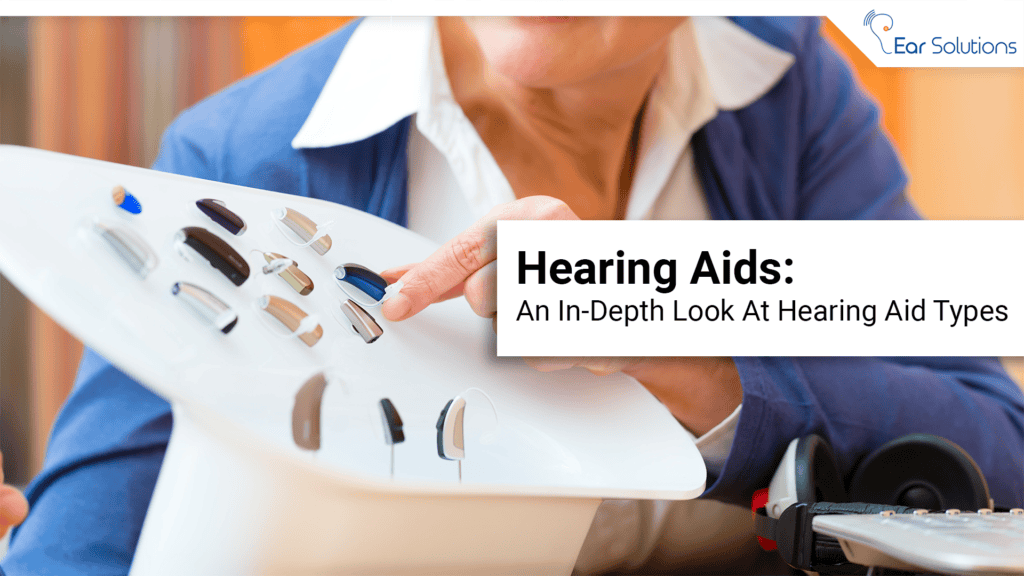Hearing aids have transformed the way individuals with hearing loss experience the world. With advancements in technology, these devices have become more sophisticated, offering solutions tailored to different types and degrees of hearing loss, lifestyle needs, and aesthetic preferences. In this blog post, we will learn more about the different types of hearing aids, their features, and whom will they suit the best.
Understanding Hearing Aids Mechanism
Hearing aids are small electronic devices designed to amplify sound for individuals with hearing loss. They consist of three main components: a microphone, an amplifier, and a speaker. The microphone picks up sound from the environment, the amplifier increases the strength of the sound signals, and the speaker delivers the amplified sound into the ear. Modern digital hearing aids also include a computer chip that processes sound, enabling advanced features like noise reduction, feedback suppression, and directional microphones.
Types of Hearing Aids
Hearing aids come in several styles, each designed to address different levels of hearing loss, aesthetic preferences, and lifestyle needs. The main types of hearing aids include:
- Behind-the-ear (BTE) Hearing Aids
- Receiver-in-Canal (RIC) Hearing Aids
- In-the-ear (ITE) Hearing Aids
- In-the-Canal (ITC) Hearing Aids
- Completely-in-Canal (CIC) Hearing Aids
- Invisible-in-Canal (IIC) Hearing Aids
1. Behind-the-Ear (BTE) Hearing Aids
Behind-the-ear (BTE) hearing aid machines are larger than other types, making them easier to handle and maintain. They are suitable for individuals with all types of hearing loss, from mild to profound.
BTE hearing aids are known for their power and versatility. Their larger size allows them to house bigger batteries, which means longer battery life. They can also accommodate a range of advanced features such as directional microphones, telecoils, and Bluetooth connectivity. These features enhance the hearing aid’s performance in different listening environments and allow users to connect to various electronic devices.
One of the significant advantages of BTE hearing aids is their durability. They are often moisture-resistant, making them a good choice for individuals who lead active lifestyles or live in humid climates. Additionally, BTE hearing aids can be customized with different earmolds to ensure a perfect fit, which helps in reducing feedback and enhancing comfort.
2. Receiver-in-Canal (RIC) Hearing Aids
Receiver-in-Canal (RIC) hearing aid devices are similar to BTE hearing aids but with a key difference: the receiver (or speaker) is placed inside the ear canal and is connected to the hearing aid by a thin wire. This design makes RIC hearing devices smaller and less visible than BTE hearing aids.
RIC hearing aids are suitable for individuals with mild to severe hearing loss. They offer an open-fit design, which reduces the occlusion effect, where users feel as if their ears are plugged.
RIC ear machines are known for their discreetness and comfort. The placement of the receiver inside the ear canal provides better sound quality and reduces feedback. They also come with advanced features like Bluetooth connectivity, directional microphones, and noise reduction, which enhance the user’s listening experience in various environments.
3. In-the-Ear (ITE) Hearing Aids
In-the-ear (ITE) hearing aids are custom-made to fit entirely within the outer ear. They come in two styles: half-shell, which fills half the outer ear, and full-shell, which fills the entire outer ear. ITE hearing aid machines are suitable for individuals with mild to severe hearing loss.
ITE hearing devices are larger than in-canal styles, making them easier to handle and adjust. Their larger size allows for the inclusion of additional features such as volume control, directional microphones, and telecoils. These features enhance the hearing aid’s functionality and improve the user’s ability to hear in different environments.
One of the significant advantages of ITE hearing aids is their custom fit. Since they are moulded to fit the user’s ear, they provide a secure and comfortable fit. This customization also helps in reducing feedback and improving sound quality.
4. In-the-Canal (ITC) Hearing Aids
In-the-canal (ITC) hearing devices are custom-made to fit partly in the ear canal. They are smaller than ITE hearing aids, offering a more discreet option for users. ITC hearing aids are suitable for individuals with mild to moderate hearing loss.
ITC hearing aid machines provide a good balance between size and feature availability. Their custom fit ensures comfort and security, and they can include features like directional microphones and wireless connectivity. These features enhance the user’s ability to hear in various listening environments.
One of the advantages of ITC hearing aids is their discreetness. They are less visible than ITE hearing aids, making them a popular choice for users who prefer a more inconspicuous device. However, their smaller size can make them harder to handle, especially for users with dexterity issues.
5. Completely-in-Canal (CIC) Hearing Aids
Completely-in-canal (CIC) hearing devices are custom-made to fit entirely inside the ear canal, making them almost invisible. They are one of the smallest types of hearing aids available and are suitable for individuals with mild to moderate hearing loss.
CIC ear machines are known for their discretion. Because they fit deep inside the ear canal, they are nearly invisible when worn. This makes them an excellent choice for users who prioritize aesthetics and prefer a hearing aid that is not noticeable.
The custom fit of CIC hearing aids ensures comfort and security, and their deep placement reduces wind noise, which can be a significant advantage for users who spend a lot of time outdoors. However, their small size makes them difficult to handle, especially for users with dexterity issues.
6. Invisible-in-Canal (IIC) Hearing Aids
Invisible-in-Canal (IIC) hearing aids are the smallest type of hearing aid, fitting deep inside the ear canal and completely invisible when worn.
IIC hearing machines offer maximum discretion. Their deep placement inside the ear canal makes them invisible to others, providing a significant advantage for users who want a completely inconspicuous hearing aid. The custom fit ensures comfort and a secure feel, and the deep placement provides natural sound quality.
However, the very small size of IIC hearing aids makes them difficult to handle, especially for users with dexterity issues. The limited space in IIC hearing aids means they have shorter battery life and fewer features compared to larger models.
Conclusion
Choosing the right hearing aid depends on several factors, including the type and severity of hearing loss, lifestyle needs, and personal preferences. Understanding the different types of hearing aids and their features can help you make an informed decision and find the best solution for your hearing needs. Consulting with an audiologist is essential to get a professional assessment and recommendation tailored to your specific situation. With the right hearing aid, you can significantly improve your hearing and overall quality of life. Meet one of the best audiologists at the Ear Solutions hearing aid clinic near you and find the best type of hearing aids.





